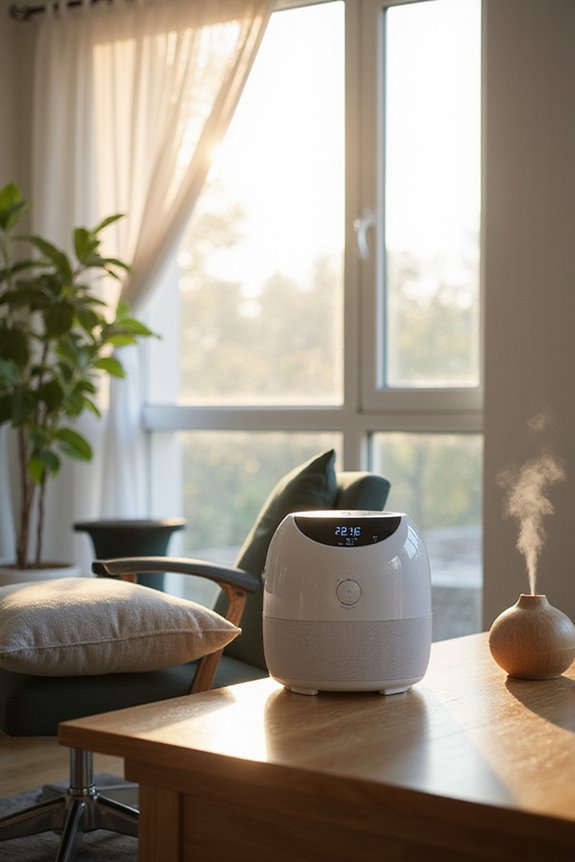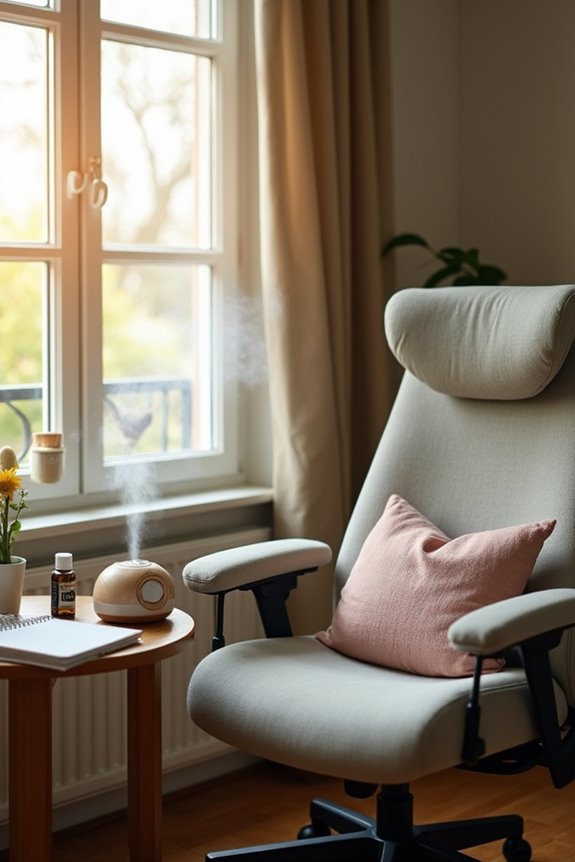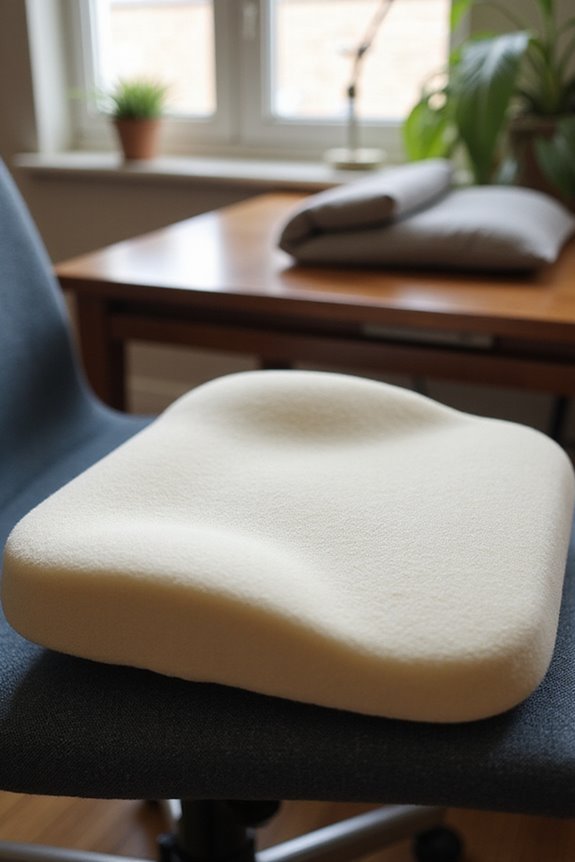Environmental factors considerably contribute to chronic pain. Key categories include:
- Natural Factors: Sunlight exposure and proximity to green spaces may alleviate pain.
- Physicochemical Factors: Air pollutants and industrial chemicals can increase inflammation.
- Psychosocial Factors: Chronic stress and social support impact pain perception.
- Sleep Factors: Poor sleep quality correlates with heightened pain intensity.
- Occupational Environment: Job stress and physical demands worsen musculoskeletal pain.
Understanding these factors provides insight into chronic pain management strategies.
Key Takeaways
- Natural environmental factors, like sunlight and green spaces, can reduce pain intensity and enhance mood.
- Airborne pollutants and indoor toxins contribute to inflammation and chronic pain syndromes.
- Chronic stress and anxiety amplify pain perception, creating a cycle of psychological distress and increased pain.
- Poor sleep quality and deprivation are strongly linked to heightened pain intensity and reduced pain inhibition.
- Supportive social networks and emotional resilience can significantly improve coping and pain management outcomes.
Natural Environmental Factors
Natural environmental factors greatly influence chronic pain experiences among individuals, as various elements in the environment can affect physiological and psychological responses.
- Sunlight Exposure: Increased sunlight exposure can enhance vitamin D levels, which may help reduce neuropathic pain through circadian pathways.
- Green Spaces: Proximity to green spaces is associated with decreased pain intensity and improved mood, facilitating stress relief and pain modulation.
- Weather Patterns: Cold, damp conditions often exacerbate chronic pain symptoms, with fluctuations in barometric pressure impacting pain intensity.
- Outdoor Activities: Engaging in outdoor activities promotes physical well-being, potentially alleviating pain.
- Nature Therapy: Exposure to natural settings fosters relaxation, reducing stress, which is a known contributor to chronic pain.
- Seasonal Affective: Seasonal changes can worsen pain and mood disorders, highlighting the importance of sunlight.
Physicochemical Environmental Factors

Physicochemical environmental factors play a critical role in the modulation of chronic pain experiences, as various pollutants and occupational exposures can substantially impact individual health outcomes.
Chemical Exposure and Air Quality
- Airborne pollutants, including particulate matter and volatile organic compounds, are linked to increased inflammation.
- Long-term exposure can lead to oxidative stress and neural damage, contributing to neuropathic pain.
- Industrial chemicals and heavy metals alter nerve function, promoting chronic pain syndromes.
Indoor Pollutants
- Formaldehyde and tobacco smoke heighten respiratory distress and pain sensitization.
- Insufficient ventilation and mold exposure can trigger inflammatory reactions, worsening chronic pain symptoms.
- Household chemicals may cause allergic responses, aggravating pain in sensitive individuals.
These physicochemical factors demonstrate significant influence on chronic pain, particularly in urban and occupational settings.
Psychosocial Environmental Factors

Psychosocial environmental factors profoundly influence the perception and management of chronic pain.
- Chronic stress dysregulates the HPA axis, increasing inflammation and pain sensitivity.
- Anxiety amplifies pain perception, creating a feedback loop that worsens both psychological distress and chronic pain symptoms.
- Social isolation correlates with higher pain severity, while supportive relationships enhance emotional resilience and coping strategies.
- Occupational and financial stressors contribute to heightened pain perceptions, impairing treatment adherence.
- Pain catastrophizing, characterized by negative thought patterns, predicts greater pain intensity and disability.
Effective stress management techniques and adaptive coping strategies, such as problem-solving and acceptance, are critical for improving outcomes. Addressing these psychosocial elements is essential for a thorough approach to chronic pain management.
Sleep and Rest Factors

How does sleep quality influence chronic pain management?
Sleep quality plays an important role in chronic pain management. Poor sleep quality correlates strongly with increased pain intensity, as interrupted sleep hinders the body’s ability to modulate pain effectively.
- Deep restorative sleep deprivation particularly heightens pain perception.
- Individuals with chronic pain often experience frequent awakenings, worsening sleep quality.
- Restricted sleep duration amplifies spontaneous pain reports and diminishes pain inhibition mechanisms.
Furthermore, insomnia symptoms may lead to worsening headache and musculoskeletal pain. Managing sleep hygiene—such as maintaining a consistent sleep schedule and creating a comfortable sleep environment—can enhance restorative sleep. Overall, addressing sleep factors is essential for improving chronic pain outcomes and breaking the cycle of pain and fatigue.
Work and Occupational Environment

What factors within the work and occupational environment contribute to the onset and persistence of chronic pain?
- Physical Work Demands: Jobs requiring repetitive movements, prolonged sitting or standing, and heavy lifting markedly elevate the risk of chronic musculoskeletal pain. Poor work ergonomics exacerbate physical strain, leading to persistent discomfort.
- Psychosocial Factors: Low job satisfaction and high work-related stress correlate with increased chronic pain prevalence. Poor relationships with colleagues and job insecurity further heighten this risk.
- Environmental Exposures: Occupational toxins and poor air quality can aggravate inflammation and pain.
Addressing these factors through ergonomic interventions and promoting a supportive workplace culture may improve job satisfaction and reduce chronic pain onset, fostering a healthier work environment for all employees.
Housing and Social Living Conditions
Housing and social living conditions greatly influence the prevalence and severity of chronic pain within populations.
- Housing Instability: Individuals experiencing homelessness or precarious housing report chronic pain rates as high as 63%. This instability exacerbates existing pain conditions and complicates efforts to secure stable housing.
- Socioeconomic Impact: Adults below the federal poverty level exhibit a notably higher prevalence of chronic pain (14.4% vs. 3.5%). Poor living conditions directly correlate with increased pain and disability.
- Social Isolation: Lack of community support and social networks contributes to heightened pain experiences. Disadvantaged neighborhoods often lack resources, increasing stress and exacerbating pain perception.
Seasonal Changes and Pain Intensity
Seasonal changes can markedly influence pain intensity among individuals suffering from chronic pain conditions. Research indicates that seasonal fluctuations can lead to varying pain perception, particularly in summer months when higher pain levels are reported.
Key findings include:
- Approximately 67% of studies link pain intensity to weather variables such as temperature and humidity.
- Cold temperatures can increase muscle stiffness, while high humidity may elevate joint pressure.
- Low barometric pressure often precedes heightened joint and nerve pain.
- Reduced physical activity during colder months may exacerbate symptoms.
- Mental distress and sleep quality do not consistently vary seasonally but can impact overall pain experience.
These insights suggest that adapting treatment strategies to account for seasonal factors is essential in managing musculoskeletal pain effectively.
The Impact of Air Pollution
Air pollution greatly influences chronic pain severity, particularly for individuals with pre-existing conditions. Research indicates that:
- Poor air quality correlates with increased fatigue and pain intensity in patients with conditions like ME/CFS, especially on days with elevated particulate matter (PM10) levels.
- Higher Air Quality Index (AQI) values are linked to worsening pain, demonstrating the impact of pollution exposure on daily symptom fluctuations.
- Systemic inflammation triggered by air pollutants exacerbates chronic pain, affecting both central and peripheral nervous system pathways.
- Patients often report heightened pain during periods of poor air quality, which can lead to increased emergency visits due to severe headache episodes.
Social Support and Pain Management
Chronic pain management is greatly influenced by social support, which plays an essential role in shaping patient outcomes. Research demonstrates that support networks provide emotional resilience, considerably reducing distress among individuals with chronic pain.
Benefits of Social Support:
- Emotional support from friends and family can buffer negative beliefs.
- Validation and esteem from social connections enhance coping skills.
- Lower stress levels correlate with reduced pain symptoms.
Types of Support:
- Emotional: Nurturance and empathy.
- Tangible: Practical assistance with daily tasks.
- Informational: Guidance on pain management.
Impact on Outcomes:
- Enhanced activity levels and reduced pain interference.
- Supportive environments improve overall pain-related quality of life.
Social support is vital for mitigating the negative perceptions of pain, ultimately leading to better patient experiences.
Frequently Asked Questions
How Do Genetics Influence Chronic Pain Susceptibility and Persistence?
Genetic markers markedly influence pain perception and susceptibility to chronic pain. Variations in specific genes impact neurotransmitter levels and pain signaling pathways, contributing to individual differences in pain intensity, persistence, and overall experiences of discomfort.
Can Diet and Nutrition Impact Chronic Pain Levels?
Can dietary choices genuinely alleviate chronic pain? The evidence suggests that incorporating anti-inflammatory foods and nutritional supplements may markedly reduce pain levels, fostering a sense of belonging through shared health journeys and improved well-being.
What Role Does Hydration Play in Managing Chronic Pain?
Hydration effects greatly influence pain relief, as proper fluid intake enhances cellular function and circulation. Maintaining adequate hydration can reduce pain sensitivity and support recovery, ultimately improving the quality of life for those experiencing chronic pain.
How Does Physical Activity Affect Chronic Pain Conditions?
Physical activity greatly benefits chronic pain conditions, with movement therapy enhancing strength and flexibility. Regular exercise fosters emotional well-being, reduces pain sensitivity, and promotes social connections, creating a supportive environment for individuals seeking relief and belonging.
Are There Alternative Therapies Effective for Chronic Pain Management?
Alternative therapies for chronic pain management include acupuncture benefits, mindfulness meditation, and herbal remedies. Additionally, chiropractic care, aromatherapy techniques, and massage therapy can enhance well-being, fostering a sense of community and support among individuals seeking relief.





